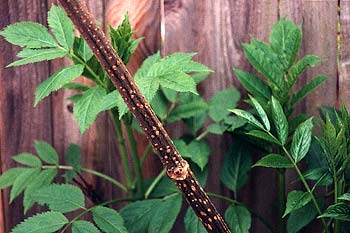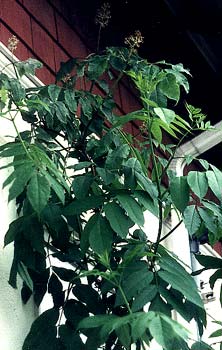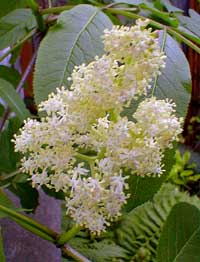
Pacific Red Elderberry
"He carved a flute of elder green,
And notched it well & true,
Then pursed his lips & puffed his cheeks
And merrily he blew."
-Maurice Thompson
(1844-1901)
(1844-1901)
One of our gardens, the "shade corridor," when we bought the house was just a mud-slick with a few weeds, & one native shrub of interest: a volunteer Pacific Red Elderberry (Sambucus racemosa pubens). Birds seed this shade-loving shrub throughout Kitsap County. We didn't originally know what it was so we used to just call it "Our Big Weed," but we loved it from the start.
Our first year in the house, we hired a kid to help out in the yard, & when our back was turned he chopped down the elderberry, knowing it to be a weed but without sufficient imagination to figure out it had gotten large because we liked it.
Fortunately it grew back with a vengeance, sending its hard, hollow, bumply trunks way up to the eaves of the house. The second photo taken in May 2002 was pointed up at the eaves to show all the higher branches. It is capable of growing to its full 20 foot height in a single year! By 2004, with a bit of underlimbing, it provided a veritable roof to its end of shade garden.
 Despite such rapid growth, the wood is extremely strong, so much so it was used in Victorian America to make combs, & rural peoples made pipestems & flutes or toy whistles from the hard hollow branches. Its very name Sambucus alludes to an ancient Greek stringed instrument made out of elder wood.
Despite such rapid growth, the wood is extremely strong, so much so it was used in Victorian America to make combs, & rural peoples made pipestems & flutes or toy whistles from the hard hollow branches. Its very name Sambucus alludes to an ancient Greek stringed instrument made out of elder wood.Elderberry branches are lightweight because hollow, & brittle enough to break in a high wind, so needs to be growing in somewhat protected area. Ours is very protected but when winds do blow through the shade corridor, this big elder wacks the side of the house, never very roughly.
As a shade-lover it prefers protection from too much sun or dryness of soil, though it's adaptable to considerable extremes. The trunks & older branches develop a handsomely lenticeled (warty) bark attractive even in winter when there are no leaves on this huge bush or small tree, as can be observed on the Pacific Elderberry Page along the Winter Bark Garden Walk.
The lance-shaped leaves are large, up to eleven inches long & three or four inches wide. In 2003 it bloomed in May way up at the top, where I couldn't get good photos of the racemes because I'd need a bigger ladder than we own. But in 2003 it was in full bloom by mid-April, from top to bottom, cloudy white tufts six or eight inches tall. A third photo below shows one of these flowers.
Many books say the whole plant smells bad, but ours smells fine, except for about a week (or less) & mainly at dusk, when the blossoms produce a skunky odor to attract pollinators. This distraction doesn't last long at all, & the plant as a whole just smells like a plant. The racemes are made up of many small creamy white flowers, which later turn to bright red berries (see the Red Elderberry Page of the Berries Gallery).
 The clusters of drupes are believed by many people to be toxic, but they are not toxic when fully ripened, not even if eaten raw, unless you chew up the seeds. The rest of the plant is toxic; the roots, flowers, seeds, & leaves, as well as the fruit's pulp while still green, possesses cyanide-producing glycosides. Medicinal teas made from the leaves can be dangerous & are definitely not recommendable, not that that keeps people from trying it.
The clusters of drupes are believed by many people to be toxic, but they are not toxic when fully ripened, not even if eaten raw, unless you chew up the seeds. The rest of the plant is toxic; the roots, flowers, seeds, & leaves, as well as the fruit's pulp while still green, possesses cyanide-producing glycosides. Medicinal teas made from the leaves can be dangerous & are definitely not recommendable, not that that keeps people from trying it.The berries include the toxin while green because this permits the plant to finish producing its seeds before the berries get harvested by wildlife. It then becomes safely eaten so that its indigestible seeds will be dispersed in the poops of bears & birds & most wildlife which is happy to eat the bright red summer fruit.
If people cannot eat them raw, it's because they taste unpleasant enough to cause a bellyache. However, cooked, with the seeds strained out of it, & spiced, they make an excellent tangy jelly. Elderberry wine is an old American favorite from days gone by. The "First Peoples" here in the Northwest prized the berries, saving them for winter use, preserved in bear-grease, or dried & pounded into cakes mixed with sweeter berries, most especially with huckleberries.
There are a number of subspecies of Elderberry which frequently hybridize even in nature. The full scientific name of the variety native to Kitsap & Olympic penninsulas is Sambucus racemosa ssp. pubens var. arborescens, commonly called the Coast or Pacific Red (or Scarlet) Elderberry. It's found all along the Pacific coast from about San Francisco to the Aleutian Islands, with naturally occurring hybrids along its range.
In the garden it has two possible appearances. We let ours grow to its full height because when permitted to be so tall, the older warty stems are beautiful for all seasons. But if they are severely pruned back in the winter, it will remain a tidier & more compact with its drupes will remain within harvestable reach.
See also the articles on European Black Elderberry & on The Mythology of Black Elderberry.